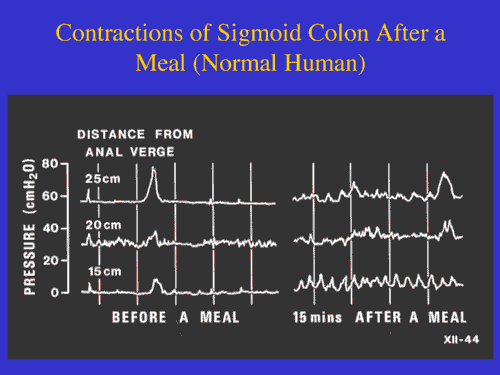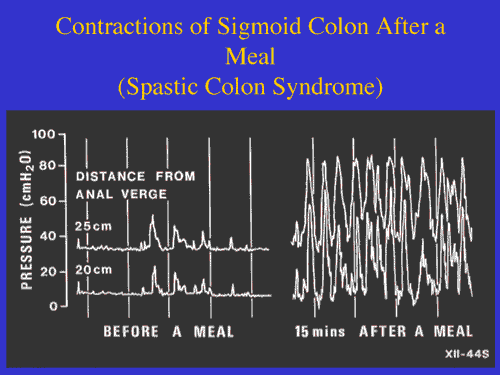Day 2 - Learning
The GI tract and how it (should) work
Day 2 Task List1. Learn how your GI tract should normally function, and what's going wrong with it when your Irritable Bowel Syndrome symptoms flare
2. Recognize the strategies that will be key to managing your health: proper diet, controlling stress, taking medications, trying alternative therapies, and using supplements
3. Be prepared to try each management strategy in turn, as well as a combination of all of them
The majority of the time the colon is still, barely moving a muscle. However, following a meal, the stomach triggers something called the "gastrocolic reflex." This response occurs when food passes from the stomach into the upper part of the small intestine.
Normally, the gastrocolic reflex causes periodic contractions of the colon at different points along its length, at timed intervals. These segmented contractions regulate the flow of waste, and keep it in contact with the bowel wall, allowing water to be absorbed.
Finally, peristaltic contractions of the colon propel the waste to the rectum and then out of the anus via evacuation by a bowel movement. Total average transit time through the entire 30-foot digestive system, from mouth to anus, is between 12-24 hours for healthy individuals with high-fiber diets, and 48-72 hours for most Americans eating a typical Western (high fat/protein, low fiber) diet.
Where Things Go Wrong...
Unfortunately, how the digestive tract is supposed to work is not exactly how it does work for those of us with IBS. The key problem seems to be with the gastrocolic reflex. Specifically, research has found that many IBS patients have highly abnormal ones.[2] Our colons have disorganized and significantly more violent and prolonged contractions (leading to diarrhea), or almost no contractions at all (resulting in constipation). Amazingly, researchers have found that while healthy people have between 6-8 peristaltic contractions in their colon within a 24-hour period, IBS sufferers with diarrhea have as many as 25 peristaltic contractions per day, and constipation-prone IBS patients have almost none. [3] Add to this bowel dysfunction the heightened pain perception resulting from our abnormal brain-gut interactions, and you've got the recipe for disaster...spelled I-B-S.


Illustration from Irritable Bowel Syndrome (IBS): Examining New Findings and Treatments. Authors: Marvin M. Schuster, MD; Michael D. Crowell, PhD; Nicholas J. Talley, MD, PhD. Continuing Medical Education Activity, Johns Hopkins School of Medicine, October 26, 2000, via Medscape. Used with permission.
These images vividly demonstrate the difference between the after-meal contractions of a normal person's lower (sigmoid) colon and the contractions of the lower (sigmoid) colon in a person with IBS. The left half of both illustrations shows the colon contractions before a meal, and the rates are very similar and quite modest. Just fifteen minutes after eating, however, the differences in colon contractions as shown on the right sides of the graphics are dramatic. Given the almost off-the-chart severity of the spasms (measured by the vertical axis in terms of pressure) in the IBS patient, it's easy to literally see exactly why the pain and bowel dysfunctions of this disorder can be so extreme.
As you read these graphics, don't be intimidated by the "distance from anal verge"legend for the horizontal axis of the chart. All that term basically means is how far up into the colon from the anus the contractions are being measured (they're either 15, 20, or 25 centimeters up into the colon from the outside of the anus). In other words, the contractions triggered by the gastrocolic reflex from the stomach are affecting the very lower end of the colon only fifteen minutes after a meal has been eaten. This gives a crystal clear explanation for just how an attack can hit you so fast and so hard after - or even while - eating.
Personally, I can't look at these charts without having flashbacks to all the times I've had to rush from the dinner table before I'd even finished my meal. The worst memory of all is from a vacation in Hawaii when I was twelve, and had been allowed to order a whole lobster for myself. Unfortunately, a virgin pina colada (in hindsight, it was the high-fat coconut milk on an empty stomach that did me in) triggered an attack before my meal had even arrived at the table. I spent the entire evening doubled over in agony in a bright pink hotel ladies lounge while my family ate my lobster. It's not much consolation to finally get a scientific explanation for exactly what happened to me that night, but I suppose it's nice to no longer be completely in the dark. And in case you're wondering, I haven't had a pina colada since.
Click here to continue reading First Year: IBS.
[2] Constipation-predominant IBS is characterized by postprandial rectal relaxation, blunted gastrocolic response, and lower rectal discomfort threshold. Diarrhea-predominant IBS is characterized by a postprandial increase in rectal tone, an enhanced gastrocolic response, and hypersensitivity to rectal distention. (Irritable Bowel Syndrome (IBS): Examining New Findings and Treatments. Authors: Marvin M. Schuster, MD; Michael D. Crowell, PhD; Nicholas J. Talley, MD, PhD. Continuing Medical Education Activity, Johns Hopkins School of Medicine, October 26, 2000, via Medscape).
[3] Hendricks, Melissa. Bowels in an Uproar, Johns Hopkins Magazine, April 1997.
All content is copyrighted by Heather Van Vorous and MAY NOT BE REPRODUCED without permission.
